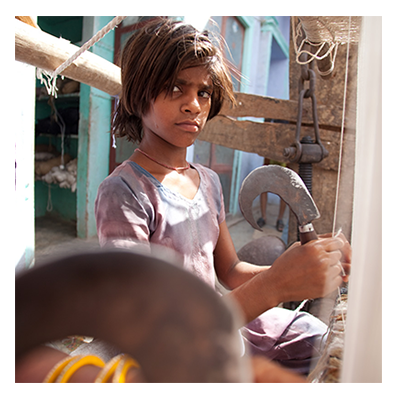CHILD LABOR
Nearly one in 10 children is working as a child laborer in the global economy. Often forfeiting the chance to ever begin school, these children have the highest illiteracy rates in the world. Victims are five to 17 years of age, and nearly half of them, 79 million, are in hazardous work. Slavery, human trafficking, prostitution, and activities that directly harm the physical, mental, and moral well-being of a child are considered “Worst Forms of Child Labor.”

GoodWeave’s certification Standard is created with input from a range of stakeholders, including workers, civil society and leading issue experts from around the world. Based on key international conventions, the Standard sets the minimum age of work at 14 or higher, depending on the national legal requirements. The Standard also prevents the employment of young workers, those between the ages of 15 and 18, from any work defined as hazardous.
Child labor is illegal under numerous laws and conventions around the world, and new legislation is pending in a number of countries. These legal frameworks combined with the UN Sustainable Development Goal 8.7 to End Child Labor by 2025 create a mandate to act.
Child labor not only impacts one generation, but every one that follows. In his 2012 report Child Labor & Educational Disadvantage–Breaking the Link, Building Opportunity, former UK Prime Minister Gordon Brown warned: “Because children who face restricted opportunities for education will receive lower wages as adults, child labor is one of the most powerful motors transmitting poverty across generations.”
Not all work performed by children is child labor. Household chores, contributing to a family business, or having an afterschool job can be beneficial and necessary. However, any work that compromises a child’s health, personal development, or schooling is considered child labor.
CHILD LABOR AND GLOBAL SUPPLY CHAINS
While corporate social auditing improves working conditions at factories, the worst exploitation often takes place outside of the factory where many layers of subcontracting turn child labor into an invisible crime. Ending child labor is everyone’s business. Child labor in supply chains looks different depending on the sector:
- In the carpet industry where GoodWeave has worked for more than 25 years, “carpet kids” sit at looms for up to 14 hours per day, using sharp tools to weave carpets with no access to education. Some are trafficked to loom sheds far from home—often under threat of violence—to work off a family debt that can never be repaid on meager wages.
- Many embellished garments are produced by hand in individual homes. Girls are often compelled to sew with their mothers to meet ambitious quotas for extremely low piece rate compensation. School absenteeism among girls during busy production periods quickly results in poor academic performance and tragically high early dropout rates.
- Entire families toil on brick kilns across South Asia. Many are bonded to the kiln and forced to work to pay off a debt. Children as young as five years old begin contributing to the family’s production quota by carrying and stacking bricks. Some children are trafficked to manage donkeys and other livestock. With long working hours and few school facilities, children face nearly insurmountable barriers to getting an education.
SUSTAINABLE DEVELOPMENT GOALS
The UN’s Sustainable Development Goal 8.7 (SDG) challenges the world to eradicate forced labor, modern slavery, and “by 2025 end child labour in all its forms.” Without addressing child labor in global supply chains, SDG 8.7 will fail to achieve its goal. The child laborers working in manufacturing and other industrial sectors, as well as the millions working in export-oriented agriculture, demand that businesses, consumers, and governments unite to realize the promise of SDG 8.7.
CHILD LABOR QUICK FACTS
- 160 million children are trapped in child labor globally. According to the ILO and UNICEF:
- 79 million are in “hazardous work,” which poses immediate danger to a child’s health, safety and moral well-being.
- The number of child laborers worldwide has increased by 8 million from 2016-2020.
- 5.6% of children in Asia and the Pacific are in child labor, and 23.9% of children in Africa are in child labor.
Child labor is a crime prosecutable under national and international laws. View a list of laws crafted to eliminate the practice of child labor and human trafficking.
